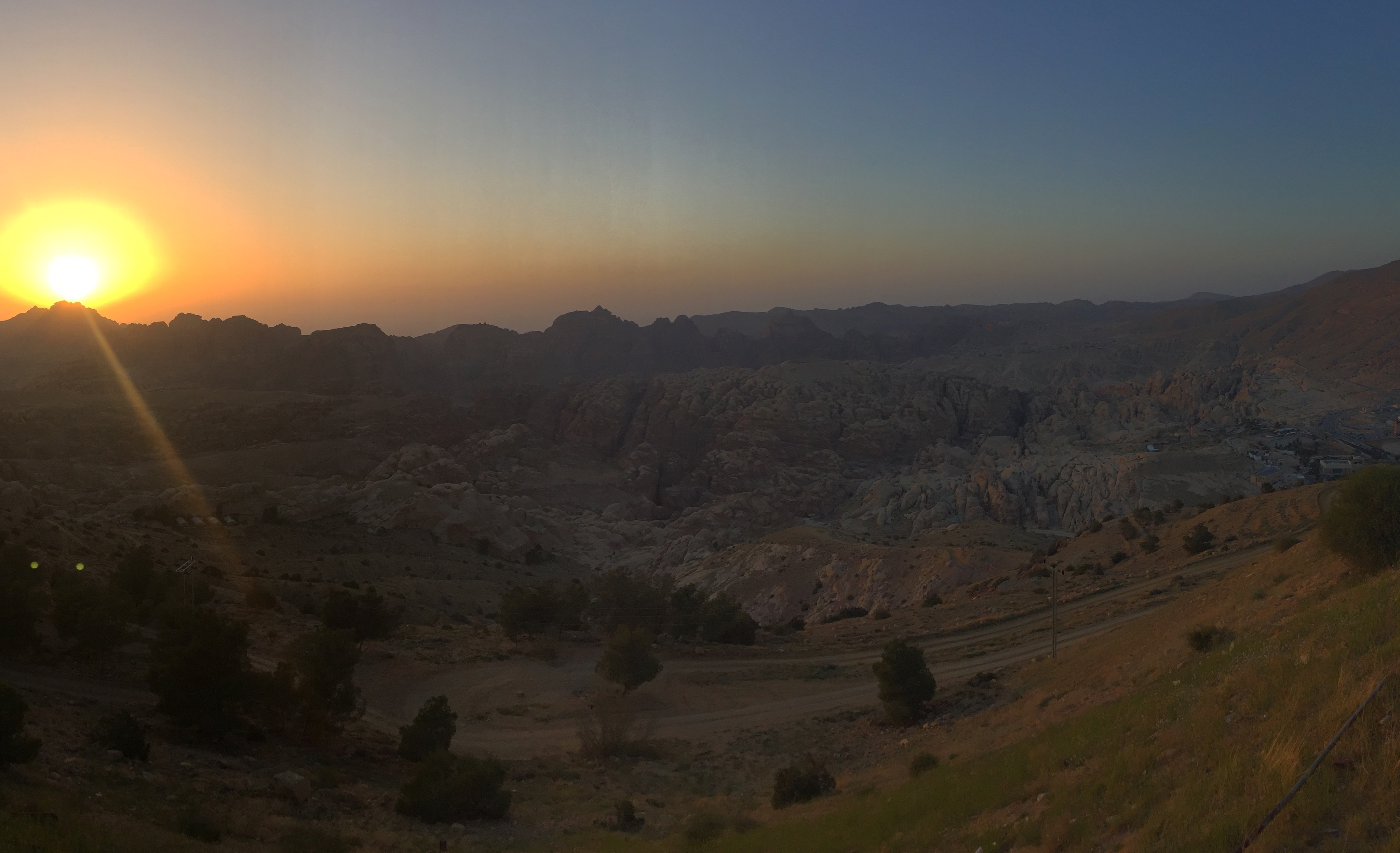Postcards from the North Coast 500
‘Wherever I wander, wherever I rove, the hills of the Highlands forever I love.’ – Robert Burns.
The legendary North Coast 500
The North Coast 500. Perhaps the UK’s most legendary road trip. And with good reason! With beauty and breathtaking splendour to be found around every corner (of which there are many!), it is little wonder this epic route has long settled in the hearts and minds of many travellers and reached great heights of fame, rivalled only by the likes of Route 66 and the Great Ocean Road.
I drove the majority of the North Coast 500 in September 2021. It was a trip long in the making and the ideal slot, between leaving my old job and starting the new, came just at the right moment. I arrived in Inverness, the self-proclaimed gateway to the Highlands, full of anticipation of what was to come. And then, dear reader, I spent the first three days of my long-awaited trip battling fog, wind and heavy rain.
Scotland’s temperamental weather did little to dampen my spirits however. Indeed, the endless fog, or ‘haar’ as the Scots call it, along the north-east coast seemed to add to the mystery and mythical status of the route. Even the merciless rain that dogged me from Thurso to Durness couldn’t dim my enthusiasm. Sure, battling with a tent in strong winds and injuring my thumb while dismantling said tent at the Kyle of Tongue wasn’t pleasant, but it was all part of the great Scottish experience, right? Lying snug in my sleeping bag those two wet nights, listening to the sound of rain on canvas, it was almost cosy.
Thankfully, the weather gods took pity on me. For the most part, my trip was one endless blur of gentle breezes, sandy beaches, watery sunshine and beautiful cloud patterns. Without further ado, here are my Postcards from the North Coast 500. Truly, one of the world’s most wonderful road trips.
Oil rigs in the Cromarty Firth
Although not strictly on the North Coast 500 route, I would recommend a detour to Cromarty if you have time.
When I arrived, the day was gloomy and rain hung heavy in the air. I walked around the small town, soaking up the convivial atmosphere, and found myself on the sea front overlooking the firth. Out of the fog which enveloped the water, huge oil rigs loomed, humming gently. The water at my feet lapped the shore lazily, as calm as a millpond, protected from the wind. A lone swimmer braved the chilly waters and swam the length of the beach before reemerging. They disappeared into the (hopefully) heated interior of a waiting car. Over the humming oil rigs, gulls mewled and boat bells clanked as the vessels rocked gently back and forth. There was the calm swish of water. The whole town seemed to be holding a breath.
I stayed longer than anticipated and caught the last ferry across the firth to Nigg on the other side. Able to carry only two cars at a time, this is the UK’s smallest car ferry. Taking it cuts off an otherwise annoying detour inland to drive around Cromarty Firth. Having saved myself an hour of driving, I gave Cromarty a last glance across the water through my rearview mirror, and set off. It was time to rejoin the North Coast 500 and get to Thurso.

A glimpse of the Duncansby Stacks
The mist followed me to Thurso and clung to the sides of the cliffs as I explored the north-east corner of Scotland. It swirled and billowed around me. The sea breezes caused it to lift, shift and re-envelope my surroundings as I walked to view the Duncansby Stacks. My views were fleeting at best, moments of opportunity to glimpse the triangular stacks before the fog swallowed them up once more. A flirtation, brief unveilings and then, in an instant, the stacks were all but gone again.
Never the less, the walk was enjoyable. Along with a huge array of sea birds, I spotted no fewer than five seals lazily swimming in the relatively calm waters offshore. They poked their round heads up and stared curiously at me as I watched them. Occasionally, they were so close we could almost hold our gazes. For a while, I sat on the springy, mossy grass and listened to the natural sounds around me. Wind whistling softly. The waves clawing at the cliffs. An occasional seabird call. The mist muffled other noises, a cloak of protection around me. I felt calm, quietly happy. At my best. I stayed until I felt chilly and then made my way back to the car, fully relaxed. The holiday was definitely underway!

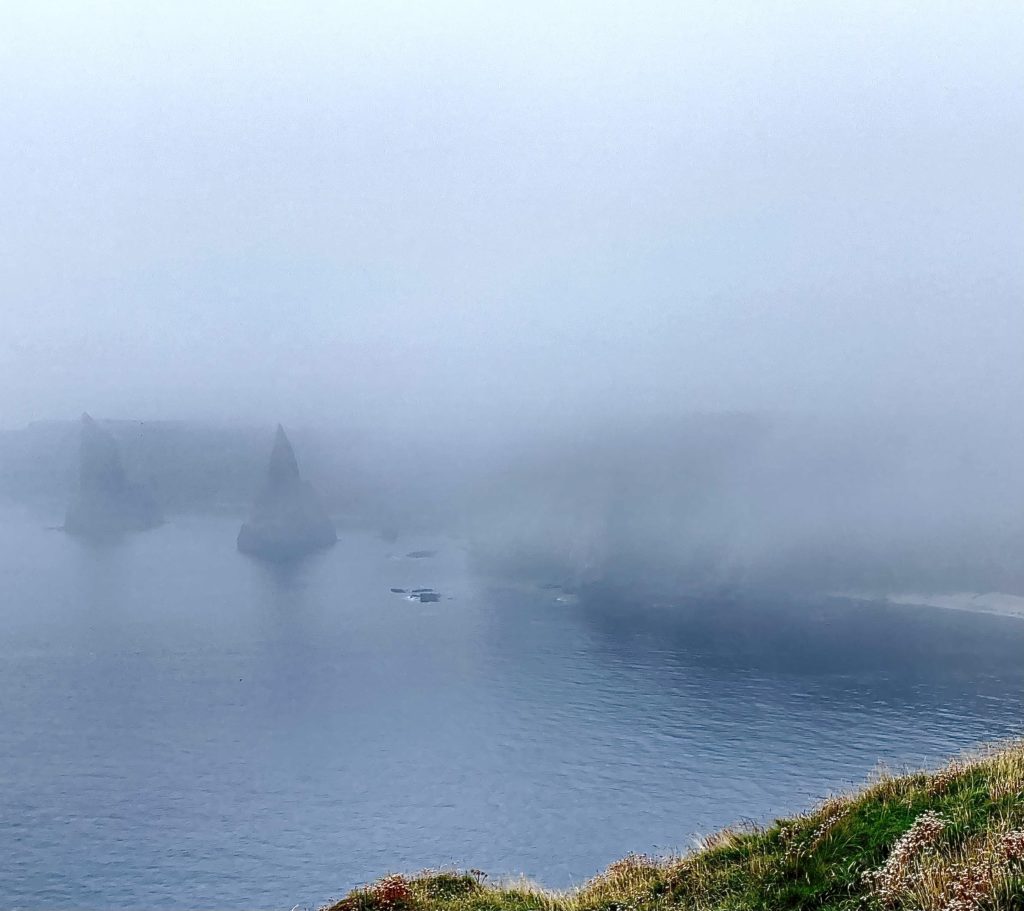
Murky John O’Groats
Fabled as one end of the famous Lands End to John O’Groats run, I wasn’t expecting much when I pulled in and parked up. Lands End, when I’d visited a couple of years earlier, hadn’t filled me with any great sense of excitement. However, maybe it was the fog, ever present, providing murky cover, or perhaps the calm waters, almost oily, that made me warm more to John O’Groats than I had to its counterpart in Cornwall.
I spent an hour there, all together. After a stroll along the pier and a brief glance at the famous signpost where the majority of the crowds were gathered, I fell to shopping. This was the perfect place to buy, write and post several postcards, all with the obligatory ‘I’m here, having a good time, weather foggy’ note. I purchased some Scottish rum, a bottle of local gin and wandered through the souvenir shops. They were both stuffed to the gills with tat – stuffed toys, key rings, fridge magnets, fudge and biscuits in ‘John O’Groats’ tins. Nevertheless, I found a couple of small items to buy as presents for friends, and it was getting on by the time I decided to leave. John O’Groats held me longer than I’d anticipated, but I wasn’t sorry for it.
As I drew out of the carpark, heading west, the first splatters of rain hit my windscreen. Ominous clouds darkened the already overcast sky. My drive to the Kyle of Tongue was going to be a wet one… Little did I know quite how wet!

Above Sango Sands
Having stayed in a rain-washed Kyle of Tongue only long enough to establish that it was very wet and that pitching tents in the dark and rain is quite difficult (e.g. I stayed less than twenty four hours, and probably should go back one day to experience it under better conditions), I arrived in Durness. The initial outlook was as bleak as the Kyle of Tongue. Rain, strong winds ripping through the clifftop camping ground and two nights stretching ahead of me under canvas. After pitching my tent in the vain hope that if it did stop raining, it might dry out more quickly than if it remained thrown in the boot of my car, I went in search of Smoo Cave.
The waterfall that plunges into the cave was in full spate after all the rain, and in seconds I was drenched from head to foot. My clothes were almost wringing with peaty water as I clambered back up from the cave, and I shivered. Getting even wetter than I already was hadn’t helped. Time for Plan B. I sought refuge at the Smoo Cave Hotel. If you are ever in Durness, and it’s a wild, wet, miserable day out, I would recommend you do the same. I spent several hours there, drying off and warming up, working my way through two hot chocolates and a lasagne with chips. When I finally ventured forth into the world again, things were looking a little brighter…
After two quite bleak, windy, wet nights in my little tent, the North Coast 500 gifted me some fairer weather. The sun shone in a watery blue sky, the clouds lifted and the sea became gentler, bluer, more approachable. Sango Sands shone golden in the sunshine that evening, and I wandered aimlessly along the clifftop enjoying a warm breeze, dressed only in shorts and t-shirt. Scottish weather – temperamental to the last.

Cape Wrath, Britain’s last outpost
If you glance at a map of the UK, it might initially look like there’s no way to reach Cape Wrath. There is no public road marked to the lighthouse, or bridge spanning the Kyle of Durness to enable a crossing. This is Cape Wrath, the most remote point on Britain’s mainland and my destination on the fourth day of my holiday. Having established that there is, in fact, a way to reach the lighthouse, I set off bright and early to catch the first come, first serve ferry that shuttles visitors across the Kyle of Durness. Along with several couples and small groups of older travellers waiting for the ferry, a troop of soldiers were also looking to be ferried across the water. This, apparently, was an unusual occurrence, despite the land around Cape Wrath being owned by the MOD.
In due course, our boat arrived and we were loaded on in groups of sixteen. Once aboard, we were motored speedily across the water to the starting point of an unmarked, pot-holed narrow lane that winds its way eleven miles to the lighthouse. As we drove, our driver regaled us with ghost stories, folklore and many interesting tidbits of information.
On the very north-western tip of the UK, we found the Cape Wrath lighthouse. Built by Robert Stevenson, grandfather to the author Robert Louis Stevenson, in 1828, this edifice has shone from this point across the storm-battered Atlantic Ocean ever since. We had an hour to wander around and explore. I took full advantage, walking a distance away before we had to board the bus for the return journey. All in all, the lighthouse was an odd anti-climax. After the thrill of the journey and the sense of adventure the boat and bumpy gravel road had invoked, I’d expected a little more.
Still. As I reflected on the exciting morning, I knew it had been totally worth it. It’s not often you get to feel like you’re on a real, proper escapade these days. Especially in the UK!
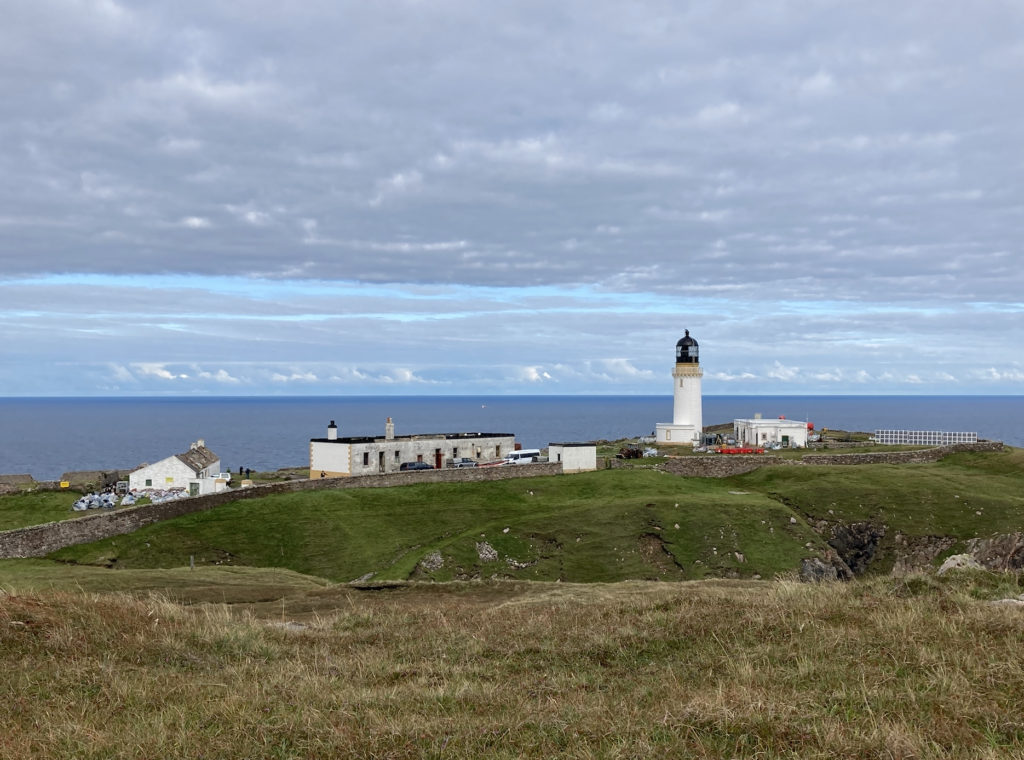
Empty beaches, blue(ish) skies
I’d heard about Scotland’s magical white sand beaches, often devoid of people. What I didn’t realise was exactly how prolific these are in the north west of the country, and how empty they are most of the time! Even in places where I expected to see people, often there was nobody else around.
This day marked the first full dry day of the trip. The rain cleared away and left behind blue skies and a sun that was warm for the time of year. I wandered further and further along the beach, then around the headland and onto another deserted stretch of sand. The tide was going out and I waded in the water, finding it warmer than I anticipated. It gently lapped against my legs and, finally, I truly felt like I was on holiday. I’d left London and my old job far behind. No stress, nothing to worry about.
I stayed on the beach until the sun started sinking and a wind picked up, making me shiver suddenly in my shorts and t-shirt. Flip-flops in hand, I turned back, paddling the majority of the way in the calm water, so flat it was almost a millpond. It came as quite a shock when I finally ran into the first people I’d seen in hours, coming down just as I scrambled up a sand dune on my way off the beach. We exchanged pleasantries. I saw nobody else until I reached the road and was walking back to my car. True emptiness.
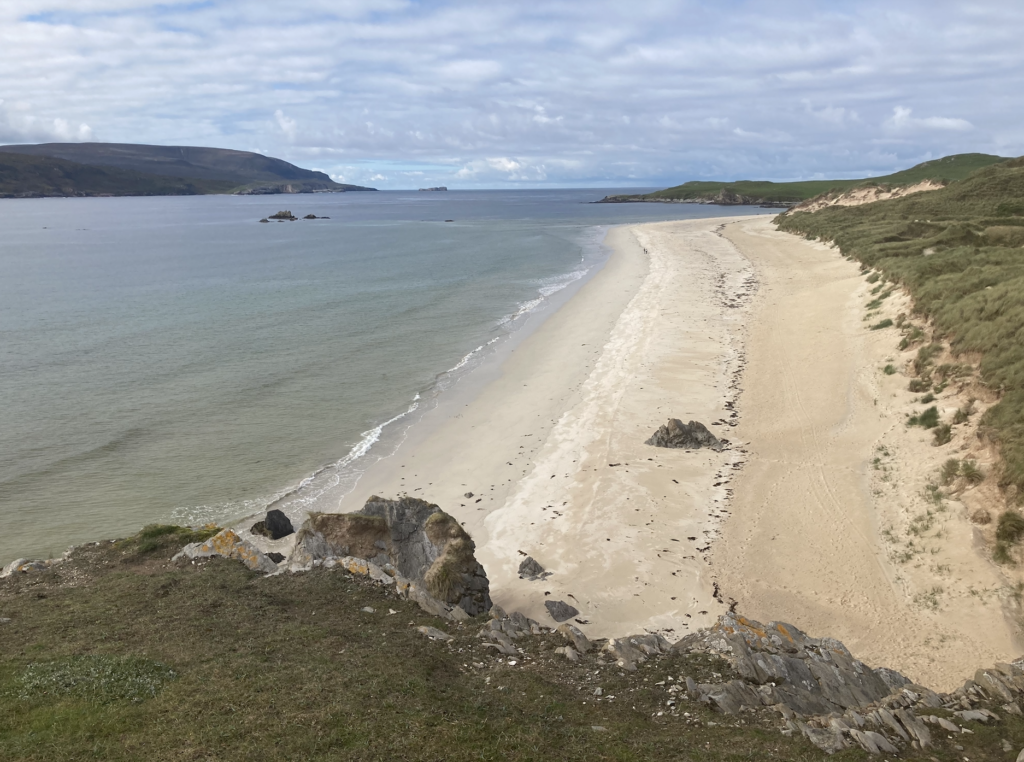
A magical land
From Durness, the drive became ever more enthralling. This was the North Coast 500 proper now, narrow winding roads, endless vistas, still deep lochs, mountains thrusting up towards the sky. A rollercoaster of breathtaking scenery and exciting driving. I pulled over frequently, leaping from the car to admire yet another stunning view and take ever more photos.
I couldn’t get over the fact that this was the UK. I’d known about Scotland, sure, but in the recess of my mind, never giving it serious consideration as a holiday destination. But here it all was, glorious, Britain’s last great wilderness. Moorland and mountains, from loch to sea, miles and miles of emptiness and rugged beauty. The closest I’d felt to New Zealand since I left for the second time in January 2019. And practically all on my doorstep! One question kept running through my mind that day – ‘Why hadn’t I come here before?‘.
As I inched south, wrapping around endless headlands and peninsulas, taking every detour, I felt grateful for this opportunity to explore my home country in more depth. It was a truly magical day, one I will hold close for a long time to come and those roads… I long to return to them, to seek further adventures, explore in ever more depth. Experience the magic all over again.
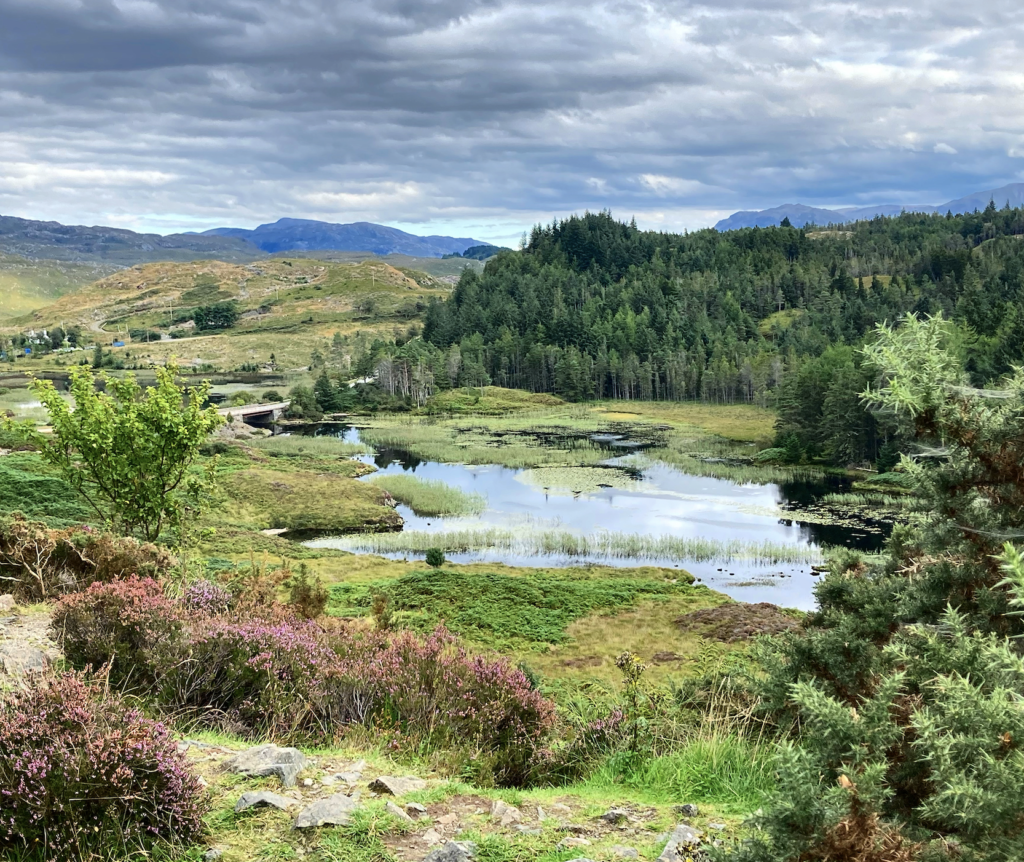
On Clachtoll Beach
I arrived late. The friendly owner welcomed me into his office and took my payment, explained the campsite amenities and showed me to my pitch. I was his last arrival of the day. Now he could relax and enjoy the balmy evening, work complete. On my part, I pitched my tent quickly, unrolled my sleeping bag and mattress and made noodles on my camping stove all within an hour. Around me, the campsite hummed with the sound of people enjoying themselves. Groups drank together, laughing and talking. Children ran around playing. I watched the scenes of every day camp life unravel before me as I spooned noodles and considered the fact that I’d added far too much water!
The light was changing. Distantly, I could hear the sound of waves lapping the shore. Dinner over, I stowed my utensils and headed for the beach. Under a mackerel sky, I slid my feet from their flip flops and curled my toes in the white-gold sand. I wandered down to the shoreline and let the waves lap at me, the water chilly but not frigid, not unenjoyable. The ocean was green-blue and shining under the tangerine edged clouds. A world of colour and light, patterns and interplay against the dark, still, age-old rocks that curved around and formed the bay in which the beach was situated.
It was, quite simply, the perfect end to a wonderful day. I took a moment, breathing in the salty air, savouring the feeling of peace and quiet. Nothing but a soft breeze and the sound of small waves breaking against… A bark, the sound of pounding paws and a spray of sand. The dog hurtled out of nowhere, launched itself into the water and pranced in delight as its beleaguered owner shouted uselessly behind it. Laughing at the dog’s cheek, and exchanging a rueful grin with the owner who was now nearing the waters edge, I turned and headed back to the campsite. Time for some downtime and then bed. It would be another day of exploring the NC500 tomorrow.
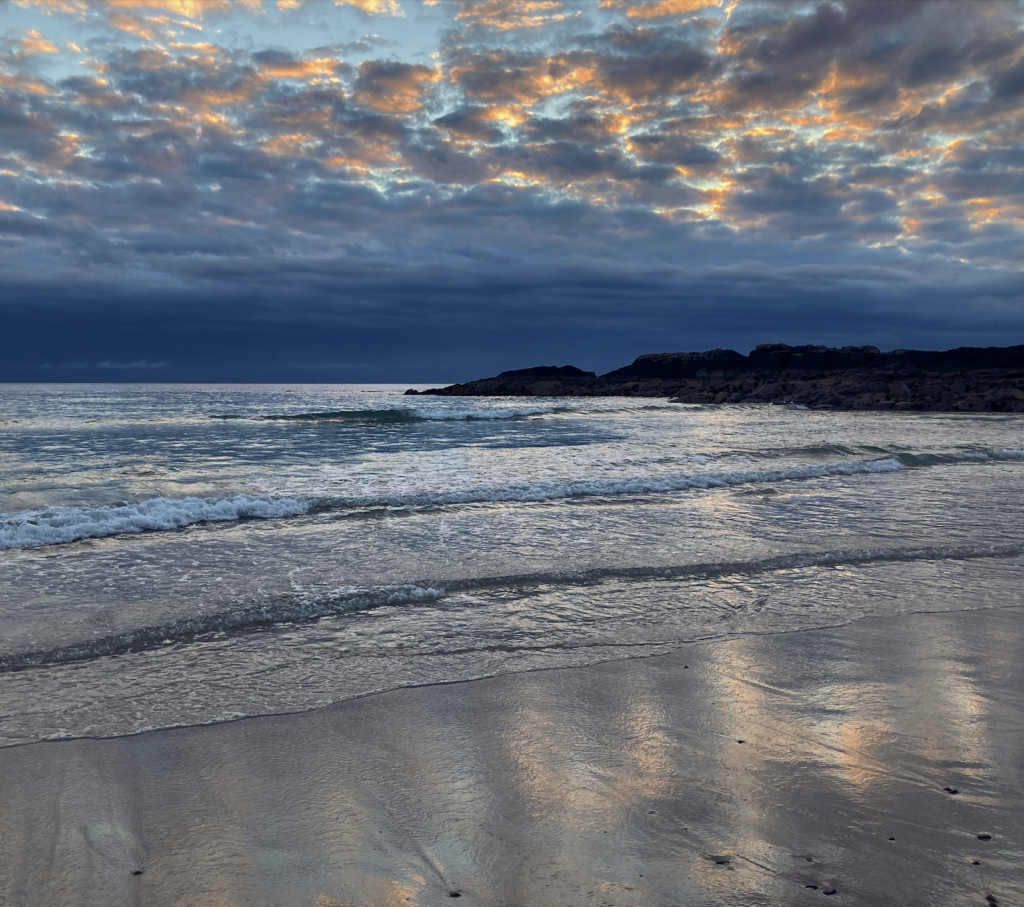
The essence of the North Coast 500
Leaving Clachtoll behind and heading ever south, the road wound, hugging the coastline tightly. I was driving at about 20mph, slowing even further periodically to admire the endless new views around every corner. It was quiet, few cars on this stretch of the coast, pulling in infrequently to allow others to pass in the opposite direction. Finally, as the road dipped and rolled to almost sea level, I decided it was time to stop for a while and have a wander and enjoy my surroundings more fully.
It turned out to be the perfect spot to stop. Here, a narrow inlet wend inland and the water was almost as slick as oil. Banks of orange seaweed clung to the rocks, and the small island just offshore looked almost walkable at such a low tide. This picture really, for me, seems to capture the very essence of the North Coast 500. Small narrow roads. Endless visionary distractions. Perfectly formed bays and inlets. A jagged, broken coastline, with a thousand islands, golden sand, water smooth as glass and almost turquoise on the sunny days. I lost count of the number of times I gasped in delight, or exclaimed over a missed opportunity to pull over for yet another view. The whole journey, from start to finish and without exception, was a delightful feast for the eyes.

Just a normal North Coast 500 view!
See a view. Pull over and stop. Snap a picture from inside the car. Realise it would probably look better if I made the effort to get out. Climb out to take another photo. Listen to the silence. Sigh happily. Get back into car. Carry on. Two minutes later, see a view… And repeat. Many, many times.
This was just one of the photos I took from within the car. For once, it turned out better than the one I took when I climbed out of the car. The road out of Durness, heading south.
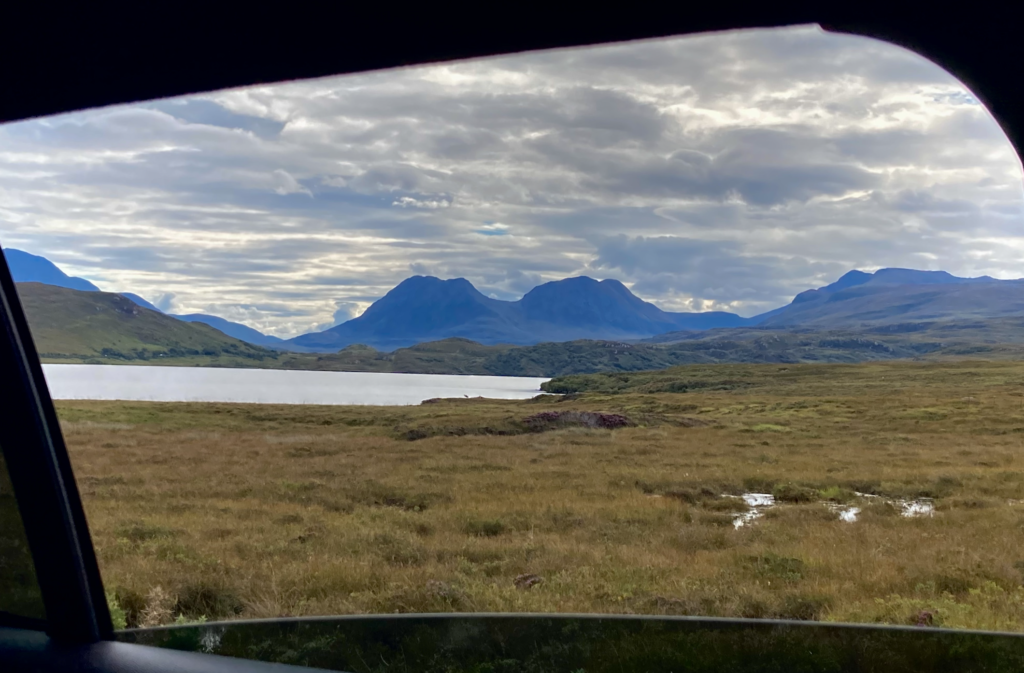
Want to read more about my adventures in Scotland? Check out my Scottish Archives for all the stories I’ve previously shared!



